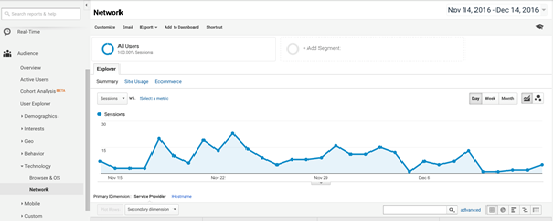UPDATE: As a result of changes in Google Analytics, taking effect on the 4th of February 2020, the information in this post is inaccurate. We leave it here as it still might be an interesting read. We changed the way we identify your website visitors, please read on here.
98% of website visitors don’t fill out your contact form. While we all know that this behavior is unacceptable and should be deeply condemned, there may be other reasons, including:
- More time to think about your offer;
- Researching your competitors is still ongoing for them;
- …Or your product/service simply does not meet certain criteria.
Whatever the reason is, you are losing valuable leads that could potentially become your customers. It’s frustrating if this happens through SEO, and costly if you run paid advertising campaigns (such as Google AdWords or Facebook ads) to acquire leads – which don’t convert.
For B2C (business to consumer) businesses this is a real issue and technology alone doesn’t solve the situation (e.g. you need human interaction – sorry for bringing you such sad news). For B2B businesses on semi-auto-pilot mode however, there is an opportunity with Google Analytics. Many business owners and marketing managers or even sales people underestimate the power of Google Analytics to help with converting site visitors into leads and leads into customers – all without having these visitors fill out a single contact form.
When you surf the Internet, you tend to lose your personality traits and become a sad little number along with the rest of Earth’s Internet surfing population of 3,424,971,237 people. You are identified with an IP address that is a collection of numbers that are usually unique to your Internet connection. (It is important to use the phrase “internet connection” here, as most homes include more than one device connecting to the same Internet, which is made possible, by a small device called the router.)
When you browse anything online from the office, the connection is shared between hundreds of computers and devices. Sometimes there isn’t just one connection being shared among employees. Most companies don’t know that those Internet connections also include a hostname field, which is a textual interpretation of the Internet connection. Why is this important to know? For home users this is usually the name of the Internet service provider (ISP) however for companies this often describes the name of the company using the Internet connection. This detail is also accessible via Google Analytics.

So this report can be used to get in touch with your visitors without them having to fill out your contact form. Although this is closer to cold calls, using this information can get you further with your sales efforts. This data in itself is still not sufficient for full success, and you need to do additional research to get specific contact info for people to get in touch with. So let’s see what are the options you have to achieve this.
1. Using Google Analytics Network report
You can locate this functionality and report within your Google Analytics account under Audience » Technology » Network

Using the Network report, you may see which companies have visited your website. The difficult bit with this method is – as mentioned above – most companies are ‘hidden’ under their Internet Service Provider’s name or some other non-distinct organization, making it difficult to see who they are in reality. You may overcome this obstacle by filtering (use the advanced search button) and selecting to exclude certain Service Providers, using a RegExp like:
(02 online |addresses |arcor ag |assigned |at&t |at-t |bell mobility inc. |block |bredband |broadband |bt-central-plus |cable |cable com |china |city of |claro s.a. |clients |comcast |comfortel ltd |communication |consumers |customer |dial-up |dna oy |dsl |elisa |embarq corporation |free sas | gesti n de direccionamiento uninet |google |hosting |hubspot |iinet limited |internet |isp |it house ltd |kpn |leased line |ncc#2006071591 |netblock |network |not set |opera mini servers |opera software americas llc |pool |provider|province |proxad |free sas |psinet inc |residential |road runner |routed |service provider |sky uk limited |sl-cgn |sonera |spark new zealand trading ltd |sprint |subscriber |sympatico hse |tdc |tele |telecom |telefonica |telia |telkom |telmex colombia s.a. |telstra |tiscali uk ltd |t-mobile |uninet s.a. de c.v. |unknown |verizon |videotron ltee |virgin media limited |vodafone |wifi |wimax |wireless |zscaler)
OK, ready? You are likely to see a much cleaner list of companies. Here, you will have the option to refine your results list even further by creating a segment of customers, e.g. from a certain country and targeting only those. Google Analytics allows you to see many different metrics about each company (sessions they had, number of pages visited, bounce rates, pages/session, etc.)
When you are onto a specific company in your report, you may want to select from Secondary dimensions and those will allow you to see what specific pages they visited (plus many other metrics are available under this button). When you have the necessary insights, it’s time to think about what it is you want to propose to them from your product or service offerings.

Google introduced another cool new function in April 2016 with the User Explorer report that allows you to see how individual visitors behaved on your website (Santa Claus could take note of this, as it would save him a lot of time to figure out if you have been naughty or nice!) To figure out what a company did on your website, simply create a segment where the Service provider matches the company you are interested in. Used this way, Analytics will show you anonymous unique visitor IDs from a given company, aiding you in understanding their thought processes when surfing through your website.

2. Using Google Analytics with Leadberry for lead generation
Using Google Analytics is a must-do for all sales and marketing teams to understand behavioral patterns and identify potential leads. As you might have noticed above, however, it still lacks real user-friendliness, when it comes to handing you actionable insights and an email to write to a person or a phone number to call someone who works at a company that was interested in your offer. Leadberry identified this gap in the cycle and developed a clever tool that takes all the goodies Google Analytics has to offer and adds in some much needed insight that results in an email you receive daily in your inbox about which companies have visited your website and who it is you can write to or call on the phone. Too good to be true? Naahh…easy does it!
Leadberry connects to your Google Analytics data and scours the hard-to-decode stuff into nice clean company names. Afterwards, it searches through different publicly available databases and adds in email addresses of people working at that company. The end-result is a beautifully simple experience (tissues, please to wipe off tears) where you click the report from your inbox, it opens up in a browser window and voilà you simply click on a company and find the person to contact. (Customers and actual phone handsets sold separately, ask your boss or mom to get these for you).
With Leadberry, there is no coding, no programming necessary - just add your sales team into the equation!
For more info, visit our site. Like this post? Share it, comment it, write to us how we could help you even more!
